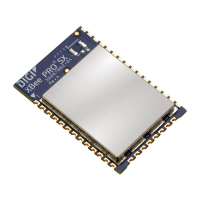Modes Modes of operation
XBee®/XBee-PRO SX RF Module User Guide
33
Feature Description
Each API transmission
can return a transmit
status frame indicating
the success or reason
for failure
Because acknowledgments are sent out of the serial interface, this
provides more information about the health of the RF network and can
be used to debug issues after the network has been deployed.
Received data frames
indicate the sender's
address
All received RF data API frames indicate the source address
Advanced addressing
support
API transmit and receive frames can expose addressing fields including
source and destination endpoints, cluster ID, and profile ID
Advanced networking
diagnostics
API frames can provide indication of I/O samples from remote devices,
and node identification messages.
Some network diagnostic tools such as
Trace Route, NACK, and Link Testing can only be performed in API mode.
Remote Configuration Set/read configuration commands can be sent to remote devices to
configure them as needed using the API
We recommend API mode when a device:
n Sends RF data to multiple destinations
n Sends remote configuration commands to manage devices in the network
n Receives RF data packets from multiple devices, and the application needs to know which
device sent which packet
API mode is required when:
n Receiving I/O samples from remote devices
n Using SPI for the serial port
If the conditions listed above do not apply (for example, a sensor node, router, or a simple application),
then Transparent operation might be suitable. It is acceptable to use a mixture of devices running API
mode and Transparent mode in a network.
Modes of operation
Receive mode
This is the default mode for the XBee/XBee-PRO SX RF Module. The device is in Receive mode when it
is not transmitting data. If a destination node receives a valid RF packet, the destination node
transfers the data to its serial transmit buffer.
If a destination node receives a valid RF packet, the destination node transfers the data to its serial
transmit buffer. For the serial interface to report received data on the RF network, that data must
meet the following criteria:
n Network ID match [ID (Network ID)]
n Preamble ID match [HP (Preamble ID)]
n Address match [SH (Serial Number High) and SL (Serial Number Low)]

